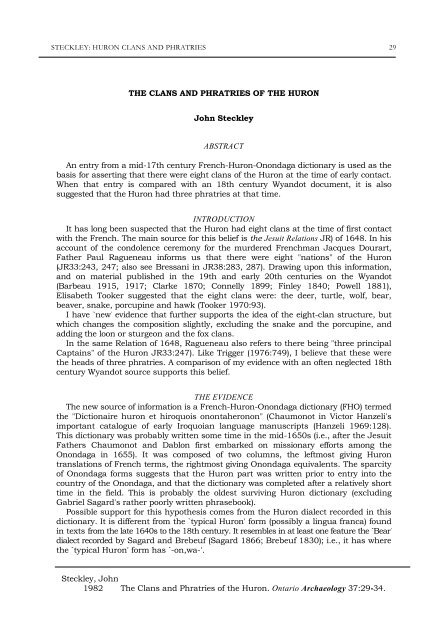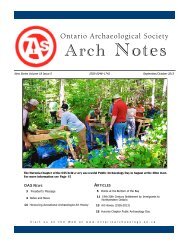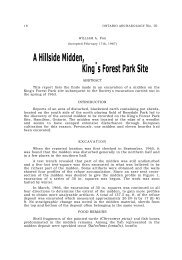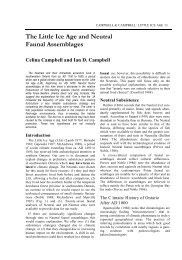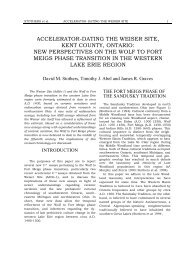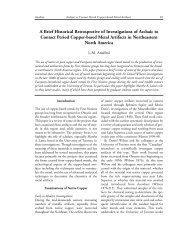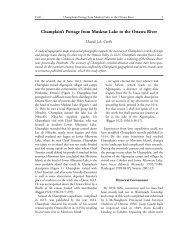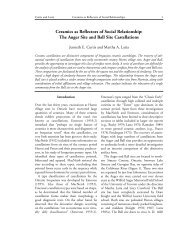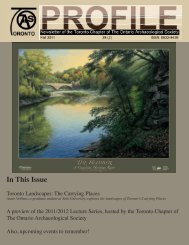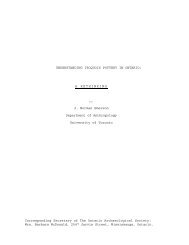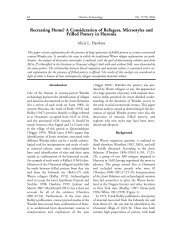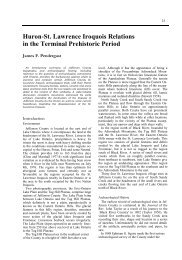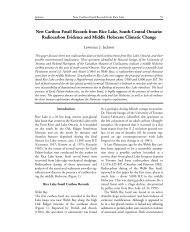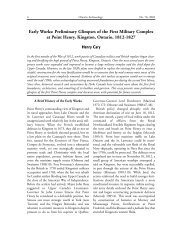THE CLANS AND PHRATRIES OF THE HURON John Steckley ...
THE CLANS AND PHRATRIES OF THE HURON John Steckley ...
THE CLANS AND PHRATRIES OF THE HURON John Steckley ...
Create successful ePaper yourself
Turn your PDF publications into a flip-book with our unique Google optimized e-Paper software.
STECKLEY: <strong>HURON</strong> <strong>CLANS</strong> <strong>AND</strong> <strong>PHRATRIES</strong> 29<br />
<strong>THE</strong> <strong>CLANS</strong> <strong>AND</strong> <strong>PHRATRIES</strong> <strong>OF</strong> <strong>THE</strong> <strong>HURON</strong><br />
<strong>John</strong> <strong>Steckley</strong><br />
ABSTRACT<br />
An entry from a mid-17th century French-Huron-Onondaga dictionary is used as the<br />
basis for asserting that there were eight clans of the Huron at the time of early contact.<br />
When that entry is compared with an 18th century Wyandot document, it is also<br />
suggested that the Huron had three phratries at that time.<br />
INTRODUCTION<br />
It has long been suspected that the Huron had eight clans at the time of first contact<br />
with the French. The main source for this belief is the Jesuit Relations JR) of 1648. In his<br />
account of the condolence ceremony for the murdered Frenchman Jacques Dourart,<br />
Father Paul Ragueneau informs us that there were eight "nations" of the Huron<br />
(JR33:243, 247; also see Bressani in JR38:283, 287). Drawing upon this information,<br />
and on material published in the 19th and early 20th centuries on the Wyandot<br />
(Barbeau 1915, 1917; Clarke 1870; Connelly 1899; Finley 1840; Powell 1881),<br />
Elisabeth Tooker suggested that the eight clans were: the deer, turtle, wolf, bear,<br />
beaver, snake, porcupine and hawk (Tooker 1970:93).<br />
I have `new ' evidence that further supports the idea of the eight-clan structure, but<br />
which changes the composition slightly, excluding the snake and the porcupine, and<br />
adding the loon or sturgeon and the fox clans.<br />
In the same Relation of 1648, Ragueneau also refers to there being "three principal<br />
Captains" of the Huron JR33:247). Like Trigger (1976:749), I believe that these were<br />
the heads of three phratries. A comparison of my evidence with an often neglected 18th<br />
century Wyandot source supports this belief.<br />
<strong>THE</strong> EVIDENCE<br />
The new source of information is a French-Huron-Onondaga dictionary (FHO) termed<br />
the "Dictionaire huron et hiroquois onontaheronon" (Chaumonot in Victor Hanzeli's<br />
important catalogue of early Iroquoian language manuscripts (Hanzeli 1969:128).<br />
This dictionary was probably written some time in the mid-1650s (i.e., after the Jesuit<br />
Fathers Chaumonot and Dablon first embarked on missionary efforts among the<br />
Onondaga in 1655). It was composed of two columns, the leftmost giving Huron<br />
translations of French terms, the rightmost giving Onondaga equivalents. The sparcity<br />
of Onondaga forms suggests that the Huron part was written prior to entry into the<br />
country of the Onondaga, and that the dictionary was completed after a relatively short<br />
time in the field. This is probably the oldest surviving Huron dictionary (excluding<br />
Gabriel Sagard's rather poorly written phrasebook).<br />
Possible support for this hypothesis comes from the Huron dialect recorded in this<br />
dictionary. It is different from the `typical Huron' form (possibly a lingua franca) found<br />
in texts from the late 1640s to the 18th century. It resembles in at least one feature the `Bear '<br />
dialect recorded by Sagard and Brebeuf (Sagard 1866; Brebeuf 1830); i.e., it has where<br />
the `typical Huron' form has `-on,wa-'.<br />
<strong>Steckley</strong>, <strong>John</strong><br />
1982 The Clans and Phratries of the Huron. Ontario Archaeology 37:29-34.
30 ONTARIO ARCHAEOLOGY NO.37<br />
The entry in the FHO dictionary which provides the evidence on the clan and phratry<br />
structure of the Huron is listed under "Aumoirie" ('Armoirie ' in modern French) or `armorial<br />
sign'. There are eight of these signs, said by the author (probably Chaumonot) to represent the<br />
"nations" or "families" of the Huron. The Huron term used in this entry is `,entiok8a' (the -,-<br />
being like -y-, the -8- being a -w- before vowels and a -u- before consonants). This noun is<br />
derived from the verb ",entio", which in Father Pierre Potier's 18th century Huron/Wyandot<br />
dictionary is given as referring to the "band" of an individual, or, more significantly, his or her<br />
"parenté" -specifically his or her "paren/t/s du cote de la mere" (Potier 1920:393 #13).<br />
The relevant material in the entry is presented in Table 1.<br />
TABLE 1<br />
FHO DICTIONARY ENTRIES<br />
Sign Gloss "Nation" or Clan Word Stem<br />
"An c nion,en ours Atinnia8enten Annia8enten<br />
hatin c nion,en<br />
oskennonton cerf sontennonk Skiatennon<br />
Andia8ich tionnenria honnontre/a/ Ontrea<br />
hotienrotori<br />
Cenrotori<br />
Ets8tai castor Satichiohare Tsochiohare<br />
Annaarisk8a loup hatinnaarisk8a Ahonrek<br />
h8enh8en huart hoti c ra,on o c ra,on<br />
Andesonk hatindesonk Arenre<br />
hatiraenre<br />
Andatsatea renard Andatse c ronnon Skanda,ona "<br />
TRANSLATIONS<br />
"An c nion,en" and "hatin c nion, en" are both derived from a verb meaning roughly `to be a<br />
bear' (Potier 1920:451; FHO "animaux"). The first term means `a bear', the second `they are<br />
bears'. "Atinnia8enten" and "Annia8enten " both stem from a verb meaning something like<br />
`to be in or of the country of the bear' (Potier 1920:450). The former, meaning `they are of<br />
the country of the bear', was also the name of the so-called Bear `tribe' of the Huron<br />
(Heidenreich 1971:301).<br />
`Oskennonton ' and cognate terms are used to refer to deer in Several Iroquoian languages<br />
(Barbeau 1961:168). It has the literal meaning of `one who goes to or is in the land of the dead '<br />
(Potier 1920:352 #60). "Sontennonk " and "skiatennon " seem to be derived from a verb<br />
meaning `to keep, take care of something or someone' (Potier 1920:378). The fact that in later<br />
years this was the clan of `Sastaretsi ' , the hereditary chief of the Wyandot (Potier 1920:151)<br />
suggests that they might have been the `keepers' of political authority or of the office of<br />
hereditary chief.<br />
"Andia8ich " was the Huron word for `turtle' (Potier 1920:449; FHO "animaux " ). The word<br />
"tionnenria " means `where or when there is a small group' (constructed with the noun<br />
",annenra " meaning "armee ... troupe . . . bande d'animaux, d ' oiseaux " (Potier 1920:450)<br />
and the verb "a " meaning `to be such a size' (Potier 1920:160 #1). This makes sense when the<br />
translations for the rest of the words in the phrase are given. "Honnontre/a/ " is derived from a<br />
verb "atrea " , meaning `to be a grandchild (maternal) ' (Potier 1920:203 #43, and can be
S T E C KLEY: HU R O N C LAN S AN D P HR ATRIES 3 1<br />
translated as `they are their grandchildren'. The final word in the phrase is difficult to translate<br />
accurately, but at least part of it is cognate with the name `Wenro ' , an Iroquoian people that<br />
joined with the Huron in the late 1630s (JR8:116, 16:252, 17:212, 18:234, 21:230 and 39:138).<br />
The whole phrase probably means something like: `When they were small they adopted the<br />
Wenro as their grandchildren.'<br />
"Ets8tai" is the term for `beaver', meaning literally `It is very shiny or brightly coloured '<br />
(Potier 1920:180 #19; FHO "animaux"; the St. Lawrence Iroquois used a cognate term:<br />
Barbeau 1961:168). "Satichiohare" and `Tsochiohare" appear to be derived from a noun<br />
plus verb combination signifying `to wash one's mouth (",achia " , mouth') (Potier 1920:446)<br />
and "ohare", `to wash' (Potier 1920:405 #12).<br />
"Annaarisk8a" and "hatinnaarisk8a " mean `wolf and `they are wolves' respectively. In his<br />
dictionary Potier claimed that this term was derived from a noun plus verb combination<br />
meaning roughly `to chew bones ' (Potier 1920:450). The term "Ahonrek" may be derived<br />
from the verb ",ari,i" meaning `to chew or suck' (Potier 1920:346 #43), thus having a meaning<br />
something like `they chew.'<br />
The term `h8enh8en" means `loon' (FHO "animaux"). The name of the clan, however, is<br />
`sturgeon'; with "hotir c a, on" and "or c aon" meaning `they are sturgeon' and `it is a sturgeon'<br />
respectively (FHO "animaux").<br />
The names "Andesonk" and "hatindesonk" mean `hawk' and `they are hawk ' (FHO<br />
"animaux"). The names "hatiraenre " and "araenre " are variations of the term used by the<br />
Huron to signify the Neutral or one part of the Neutral (White 1978:411). It may be derived<br />
from a verb ",a,enie " meaning `to roll or turn over', possibly relating to the fact that the<br />
Neutral (or one particular subgroup of the Neutral) had been turned over or rolled over in<br />
defeat (Potier 1920:245). They may have been adopted into the hawk clan as the Wenro were<br />
adopted into the turtle clan.<br />
"Andatsatea " means `fox', and "Andatse c ronnon " , `the people of the fox' (FH O "animaux " ).<br />
The term "Skanda,ona", I have so far been unable to translate.<br />
This clan structure differs only slightly from the Seneca, Cayuga and Onondaga (Tooker<br />
1970:94).<br />
TABLE 2<br />
CLAN MEMBERSHIP <strong>OF</strong><br />
<strong>THE</strong> <strong>HURON</strong>, SENECA, CAYUGA <strong>AND</strong> ONONDAGA<br />
Huron Seneca Cayuga Onondaga<br />
Bear Bear Bear Bear<br />
Deer (Keepers) Deer Deer Deer<br />
Turtle Turtle Turtle Turtle<br />
Beaver Beaver Beaver Beaver<br />
Wolf Wolf Wolf Wolf<br />
Sturgeon Heron Eel Eel<br />
Hawk Hawk Hawk Ball<br />
Fox Snipe Snipe Snipe<br />
<strong>PHRATRIES</strong><br />
It is instructive to compare the terms in Table 2 with a list of the clans and phratries of the<br />
Wyandot recorded by Potier in the mid-1740's (Potier 1920:151) as given in Table 3.
32 ONTARIO ARCHAEOLOGY NO.37<br />
TABLE 3<br />
POTIER'S WY<strong>AND</strong>OT <strong>PHRATRIES</strong> <strong>AND</strong> <strong>CLANS</strong> (ADAPTED)<br />
1) "Cskennonton " (Deer) Phratry:<br />
a) "esontennonk " (keepers) clan;<br />
b) "e,angontr8nnon " (snake) clan;<br />
c) "hatinnion,en " (bear) clan.<br />
2) ",andia8ich" (Turtle) Phratry:<br />
a) "ennienstenronnon" (?)* clan;<br />
b) "eronisseeronnon " (?)* clan;<br />
c) "a c tieronnon " (?)* clan;<br />
d) "entioronnon " (prairie turtle; Barbeau 1915:86 fn2) clan.<br />
3) ",annaariska8a" (Wolf) Phratry:<br />
a) "hatinnaariska8a" (wolf) clan;<br />
b) "hatindesonk " (hawk) clan;<br />
c) "hotira,on" (sturgeon) clan;<br />
d) "ti,ata,entsi " (they are old) clan.<br />
C These are probably all the names of various kinds of turtles; see<br />
Barbeau 1915:85-6.<br />
TABLE 4<br />
A COMPARISON <strong>OF</strong> <strong>THE</strong> WY<strong>AND</strong>OT <strong>AND</strong> <strong>HURON</strong><br />
CLAN LISTS<br />
Wyandot<br />
Huron<br />
1) Deer phratry<br />
a) Keepers (Deer) Bear<br />
b) Bear Keepers (Deer)<br />
2) Turtle phratry Turtle<br />
Beaver<br />
3) Wolf phratry<br />
a) Wolf Wolf<br />
b) Hawk Sturgeon<br />
c) Sturgeon Hawk<br />
Fox<br />
The similarity between the lists of tables 2 and 3 is quite striking, particularly in the order in<br />
which the clans are presented. removing from the Wyandot list (Table 3) the clans that do not<br />
appear on the previous list (Table 2), we have the comparison shown in Table 4.<br />
The marked similarity between the two lists suggests to me that the early Huron list was not<br />
written in random order, but according to phratry. Further, I would contend that Huron<br />
society had three phratries at the time that the French-Huron Onondaga dictionary was
STECKLEY: <strong>HURON</strong> <strong>CLANS</strong> <strong>AND</strong> <strong>PHRATRIES</strong> 33<br />
written: the bear; the turtle; and the wolf The bear phratry would then contain the bear and deer<br />
clans; the turtle phratry, the turtle and beaver clans; and the wolf phratry, the wolf, hawk, loon or<br />
sturgeon and fox clans. That this would place an animal associated with water in the turtle<br />
phratry, and a Canidae predator in the wolf phratry, seems to make this contention more<br />
credible.<br />
This three-part Huron phratry structure would then mirror exactly the three `clan ' system of the<br />
Mohawk and Oneida (Tooker 1970:92). Perhaps, like the Mohawk and Oneida, the three<br />
phratries could reform into two moities for ceremonial purposes (Tooker 1970:93): i.e., with the<br />
bear and turtle phratries combining into one four-clan unit, the wolf phratry providing the other.<br />
If such was the case, it would be tempting to identify the first unit as the Bear `tribe ' , the<br />
second as the Cord `tribe'. The `newcomers' into the area, the Deer `tribe ' and the Rock `tribe '<br />
might have aligned themselves with one of the two moieties; the Deer with their neighbours the<br />
Bear/Turtle moiety (which contained the deer clan), the Rock with their Wolf moiety<br />
neighbours.<br />
It would be further tempting to suggest that the split noted by Trigger between the northern<br />
and southern Bear (Trigger 1976: 57, 290-2, 475-6, 518-20, 539) was not just the result of<br />
recent grievances, but was based on a division of the Bear into bear and turtle moieties. Such an<br />
assertion is supported rather tenuously by two facts. The name of the leader of the northern Bear<br />
faction, -Aen(n)ons-, was borne in the 18th century by the leader of the bear clan of the<br />
Wyandot (Potier 1920:15). As names were probably considered to be clan property (Trigger<br />
1976:47) it is likely that the person who bore the name in the 1630 ' s was also prominent in that<br />
clan. The leader of the southern Bear faction was based in Ossossane, the village into which the<br />
bulk of the Wenro were adopted (Trigger 1976:562). As we have seen, the Wenro were adopted<br />
into the turtle clan. Ossossane was thus probably a turtle stronghold.<br />
This, however, is stretching beyond the credible limits of the data now at hand. Further<br />
linguistic investigation is necessary (i.e., the analysis of personal and place names) before such<br />
statements can be made with any authority.<br />
REFERENCES CITED<br />
Barbeau, Charles Marius<br />
1915 Huron and Wyandot Mythology. Canada, Department of Mines, Geological<br />
Survey, Memoir 80.<br />
1917 Iroquoian Clans and Phratries. American Anthropologist 19:392-402.<br />
1961 The Language of Canada in the Voyages of Jacques Cartier (1534-1538).<br />
In Contributions to Anthropology, 1959, National Museum of Canada, Bulletin 173:<br />
108-229.<br />
Brebeuf, Jean de<br />
1830 Doctrine Chrestienne, dv R. P. Ledesme de la Compagnie de Iesys. In<br />
Samuel de Champlain's Voyages; ou journal des descouvertes de la Nouvelle France<br />
(3 volumes). Paris.
34 ONTARIO ARCHAEOLOGY NO.37<br />
Chaumonot, Pierre Joseph-Marie<br />
ca 1656 Dictionaire huron et hiroquois onontaheronon. Manuscript. (FHO)<br />
Clarke, Peter D.<br />
1870 Origin and Traditional History of the Wyandotts. Hunter, Rose & Co. Toronto.<br />
Connelly, William<br />
1900 The Wyandots. In Annual Archaeological Report, Appendix to the Report of the Minister of<br />
Education of Ontario for 1899, pp. 92-123.<br />
FHO See Chaumonot ca 1656<br />
Finley, James<br />
1840 History of the Wyandot Mission at Upper Sandusky, Ohio. Cincinnati.<br />
Hanzeli, Victor<br />
1969 Missionary Linguistics in New France. Mouton. The Hague.<br />
Heidenreich, Conrad<br />
1971 Huronia: A History and Geography of the Huron Indians, 1600-1650. McClelland and<br />
Stewart. Toronto.<br />
JR<br />
1896- The Jesuit Relations and Allied Documents (73 volumes). Edited by Reuben Gold<br />
1901 Thwaites. The Burrows Brothers Company. Cleveland.<br />
Potier, Pierre<br />
1920 Elementa grammaticae huronicae, 1745 (facsimilie of manuscript in St.<br />
Mary ' s College, Montreal). Fifteenth Report of the Bureau of Archives for the Province of<br />
Ontario, 1918-1919, pp. 1-157. Toronto.<br />
Powell, J. W.<br />
1881 Wyandot Government. Bureau of American Ethnology, 1st Annual Report, pp. 57-69.<br />
Washington, D.C.<br />
Sagard, Gabriel<br />
1866 Histoire du Canada et voyages que les Freres mineurs recollects y out<br />
faicts pour la conversion des infideles depuis l'an 1615... avec un<br />
dictionnaire de la langue huronne (4 volumes). Originally published 1636.<br />
Paris.<br />
Tooker, Elisabeth<br />
1970 Northern Iroquoian Sociopolitical Organization. American Anthropologist 72: 90-97.<br />
Trigger, Bruce G.<br />
1976 The Children of Aataentsic: A History of the Huron People to 1660 (2 volumes). McGill-<br />
Queen ' s University Press. Montreal.<br />
White, Marian<br />
1978 Neutral and Wenro. In Handbook of North American Indians (William C.<br />
Sturtevant, ed.), Vol. 15, Northeast (Bruce G. Trigger, ed.), pp. 407-411.<br />
Washington, D.C.<br />
Apt. #105<br />
20 Forest Manor Road<br />
Willowdale, Ontario M2J 1M2


